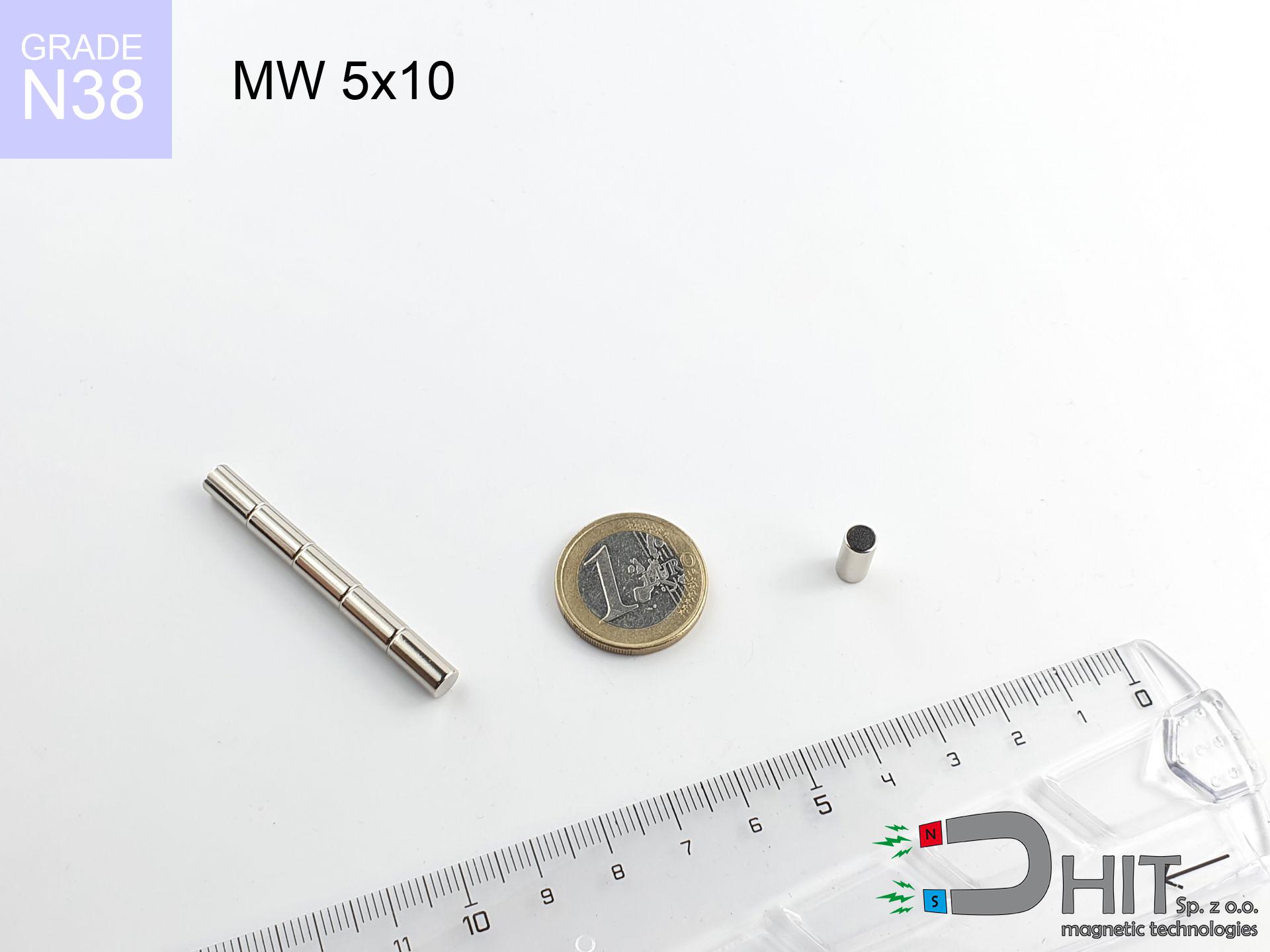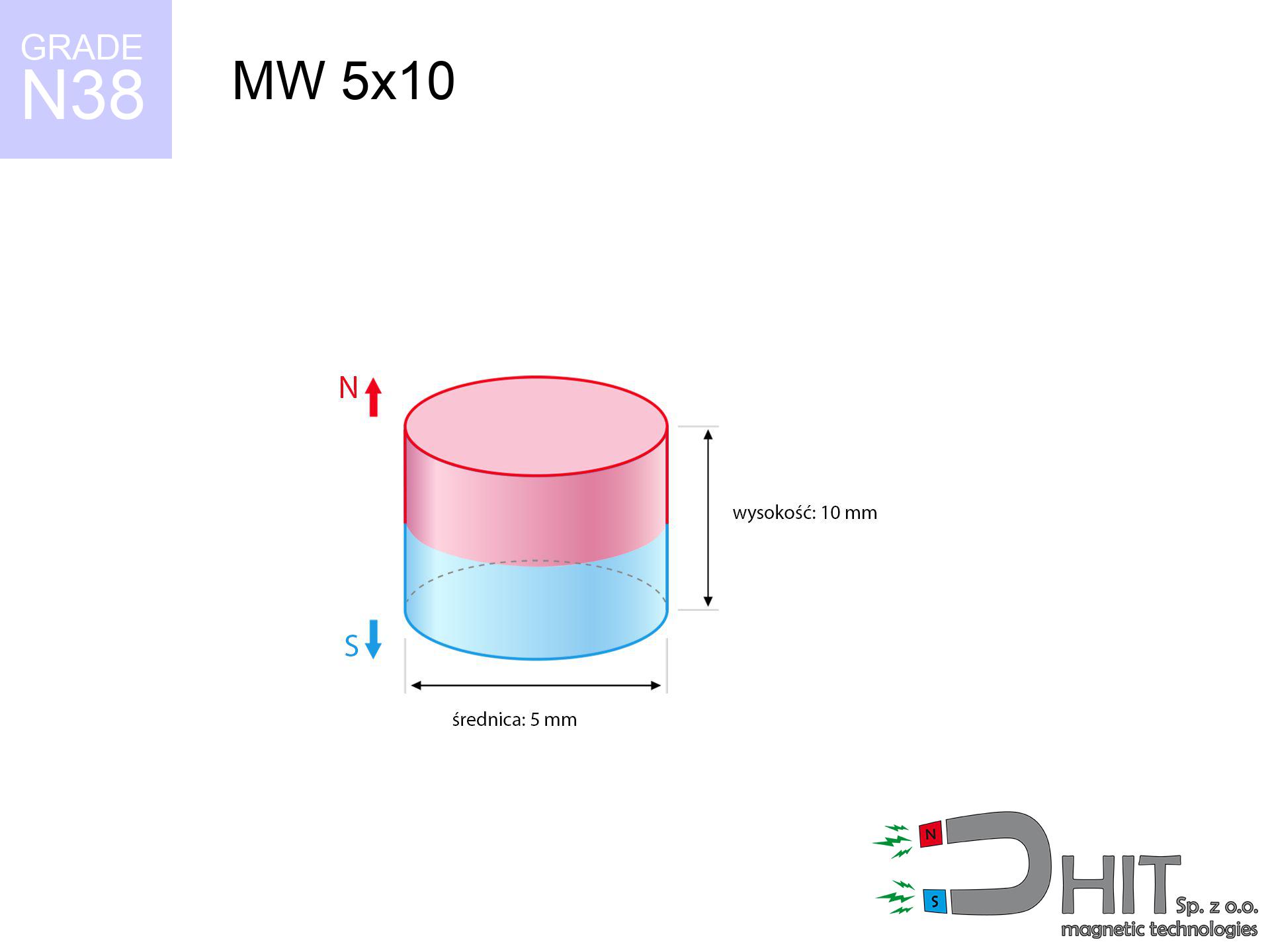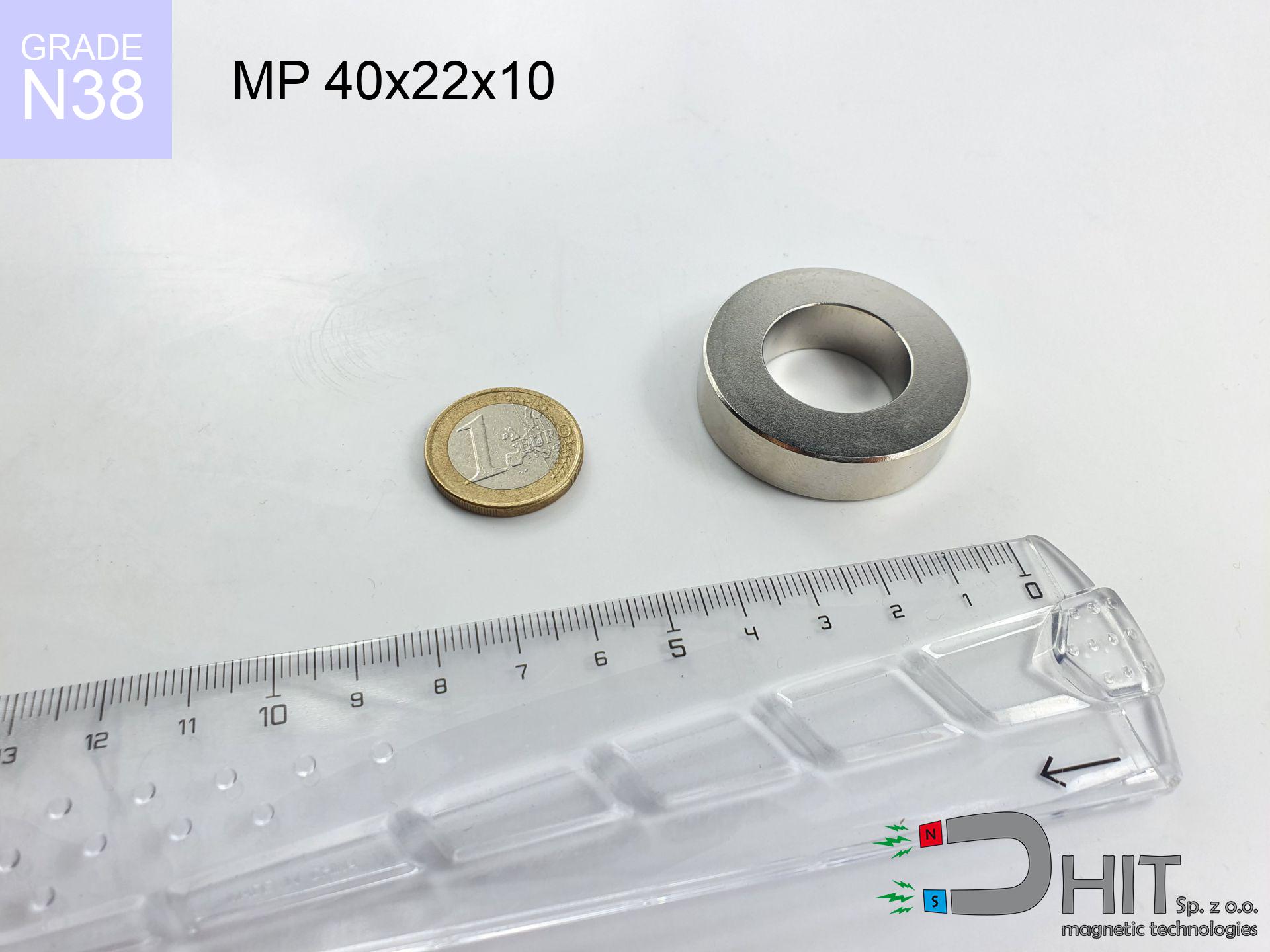MW 5x10 / N38 - cylindrical magnet
cylindrical magnet
Catalog no 010083
GTIN: 5906301810827
Diameter Ø
5 mm [±0,1 mm]
Height
10 mm [±0,1 mm]
Weight
1.47 g
Magnetization Direction
↑ axial
Load capacity
1.49 kg / 14.63 N
Magnetic Induction
599.97 mT
Coating
[NiCuNi] Nickel
0.800 ZŁ with VAT / pcs + price for transport
0.650 ZŁ net + 23% VAT / pcs
bulk discounts:
Need more?Do you have a dilemma?
Call us
+48 22 499 98 98
otherwise contact us via
our online form
through our site.
Specifications along with structure of neodymium magnets can be analyzed using our
our magnetic calculator.
Same-day shipping for orders placed before 14:00.
MW 5x10 / N38 - cylindrical magnet
Specification / characteristics MW 5x10 / N38 - cylindrical magnet
| properties | values |
|---|---|
| Cat. no. | 010083 |
| GTIN | 5906301810827 |
| Production/Distribution | Dhit sp. z o.o. |
| Country of origin | Poland / China / Germany |
| Customs code | 85059029 |
| Diameter Ø | 5 mm [±0,1 mm] |
| Height | 10 mm [±0,1 mm] |
| Weight | 1.47 g |
| Magnetization Direction | ↑ axial |
| Load capacity ~ ? | 1.49 kg / 14.63 N |
| Magnetic Induction ~ ? | 599.97 mT |
| Coating | [NiCuNi] Nickel |
| Manufacturing Tolerance | ±0.1 mm |
Magnetic properties of material N38
| properties | values | units |
|---|---|---|
| remenance Br [Min. - Max.] ? | 12.2-12.6 | kGs |
| remenance Br [Min. - Max.] ? | 1220-1260 | T |
| coercivity bHc ? | 10.8-11.5 | kOe |
| coercivity bHc ? | 860-915 | kA/m |
| actual internal force iHc | ≥ 12 | kOe |
| actual internal force iHc | ≥ 955 | kA/m |
| energy density [Min. - Max.] ? | 36-38 | BH max MGOe |
| energy density [Min. - Max.] ? | 287-303 | BH max KJ/m |
| max. temperature ? | ≤ 80 | °C |
Physical properties of sintered neodymium magnets Nd2Fe14B at 20°C
| properties | values | units |
|---|---|---|
| Vickers hardness | ≥550 | Hv |
| Density | ≥7.4 | g/cm3 |
| Curie Temperature TC | 312 - 380 | °C |
| Curie Temperature TF | 593 - 716 | °F |
| Specific resistance | 150 | μΩ⋅Cm |
| Bending strength | 250 | Mpa |
| Compressive strength | 1000~1100 | Mpa |
| Thermal expansion parallel (∥) to orientation (M) | (3-4) x 106 | °C-1 |
| Thermal expansion perpendicular (⊥) to orientation (M) | -(1-3) x 10-6 | °C-1 |
| Young's modulus | 1.7 x 104 | kg/mm² |
Magnetic Efficiency Report
Results are based on physical models for sintered magnets. Real-world results may differ from the simulation.
MW 5x10 / N38
| Distance (mm) | Induction (Gauss) / mT | Pull Force (kg) | Risk Status |
|---|---|---|---|
| 0 mm |
5990 Gs
599.0 mT
|
0.37 kg / 374.8 g
3.7 N
|
Safe |
| 1 mm |
3743 Gs
374.3 mT
|
0.15 kg / 146.3 g
1.4 N
|
Safe |
| 2 mm |
2197 Gs
219.7 mT
|
0.05 kg / 50.4 g
0.5 N
|
Safe |
| 5 mm |
570 Gs
57.0 mT
|
0.00 kg / 3.4 g
0.0 N
|
Safe |
| 10 mm |
137 Gs
13.7 mT
|
0.00 kg / 0.2 g
0.0 N
|
Safe |
| 15 mm |
54 Gs
5.4 mT
|
0.00 kg / 0.0 g
0.0 N
|
Safe |
| 20 mm |
26 Gs
2.6 mT
|
0.00 kg / 0.0 g
0.0 N
|
Safe |
| 30 mm |
9 Gs
0.9 mT
|
0.00 kg / 0.0 g
0.0 N
|
Safe |
| 50 mm |
2 Gs
0.2 mT
|
0.00 kg / 0.0 g
0.0 N
|
Safe |
MW 5x10 / N38
| Surface Type | Friction Coeff. | Max Load (kg) |
|---|---|---|
| Raw Steel | µ = 0.3 |
0.11 kg / 112.4 g
1.1 N
|
| Painted Steel (Standard) | µ = 0.2 |
0.07 kg / 75.0 g
0.7 N
|
| Greasy/Slippery Steel | µ = 0.1 |
0.04 kg / 37.5 g
0.4 N
|
| Magnet with Anti-slip Rubber | µ = 0.5 |
0.19 kg / 187.4 g
1.8 N
|
MW 5x10 / N38
| Steel Thickness (mm) | % Efficiency | Real Pull Force (kg) |
|---|---|---|
| 0.5 mm |
|
0.04 kg / 37.5 g
0.4 N
|
| 1 mm |
|
0.09 kg / 93.7 g
0.9 N
|
| 2 mm |
|
0.19 kg / 187.4 g
1.8 N
|
| 5 mm |
|
0.37 kg / 374.8 g
3.7 N
|
| 10 mm |
|
0.37 kg / 374.8 g
3.7 N
|
MW 5x10 / N38
| Ambient Temp. (°C) | Power Loss | Remaining Pull | Status |
|---|---|---|---|
| 20 °C | 0.0% |
0.37 kg / 374.8 g
3.7 N
|
OK |
| 40 °C | -2.2% |
0.37 kg / 366.5 g
3.6 N
|
OK |
| 60 °C | -4.4% |
0.36 kg / 358.3 g
3.5 N
|
OK |
| 80 °C | -6.6% |
0.35 kg / 350.0 g
3.4 N
|
|
| 100 °C | -28.8% |
0.27 kg / 266.8 g
2.6 N
|
MW 5x10 / N38
| Air Gap (mm) | Attraction (kg) (N-S) | Repulsion (kg) (N-N) |
|---|---|---|
| 0 mm |
0.55 kg / 555.0 g
5.4 N
|
N/A |
| 2 mm |
0.08 kg / 75.0 g
0.7 N
|
0.07 kg / 70.0 g
0.7 N
|
| 5 mm |
0.00 kg / 0.0 g
0.0 N
|
0.00 kg / 0.0 g
0.0 N
|
| 10 mm |
0.00 kg / 0.0 g
0.0 N
|
0.00 kg / 0.0 g
0.0 N
|
| 20 mm |
0.00 kg / 0.0 g
0.0 N
|
0.00 kg / 0.0 g
0.0 N
|
| 50 mm |
0.00 kg / 0.0 g
0.0 N
|
0.00 kg / 0.0 g
0.0 N
|
MW 5x10 / N38
| Object / Device | Limit (Gauss) / mT | Safe Distance |
|---|---|---|
| Pacemaker | 5 Gs (0.5 mT) | 4.0 cm |
| Hearing Aid / Implant | 10 Gs (1.0 mT) | 3.0 cm |
| Mechanical Watch | 20 Gs (2.0 mT) | 2.5 cm |
| Phone / Smartphone | 40 Gs (4.0 mT) | 2.0 cm |
| Car Key | 50 Gs (5.0 mT) | 2.0 cm |
| Credit Card | 400 Gs (40.0 mT) | 1.0 cm |
| Hard Drive (HDD) | 600 Gs (60.0 mT) | 0.5 cm |
MW 5x10 / N38
| Start from (mm) | Speed (km/h) | Energy (J) | Predicted Effect |
|---|---|---|---|
| 10 mm |
16.09 km/h
(4.47 m/s)
|
0.01 J | |
| 30 mm |
27.87 km/h
(7.74 m/s)
|
0.04 J | |
| 50 mm |
35.98 km/h
(9.99 m/s)
|
0.07 J | |
| 100 mm |
50.88 km/h
(14.13 m/s)
|
0.15 J |
MW 5x10 / N38
| Technical Parameter | Value / Description |
|---|---|
| Coating Type | [NiCuNi] Nickel |
| Layer Structure | Nickel - Copper - Nickel |
| Layer Thickness | 10-20 µm |
| Salt Spray Test (SST) ? | 24 h |
| Recommended Environment | Indoors only (dry) |
Other proposals
Pros as well as cons of neodymium magnets.
Apart from their superior power, neodymium magnets have these key benefits:
- They virtually do not lose strength, because even after ten years the decline in efficiency is only ~1% (based on calculations),
- They do not lose their magnetic properties even under close interference source,
- A magnet with a metallic nickel surface has better aesthetics,
- Magnets have excellent magnetic induction on the active area,
- Made from properly selected components, these magnets show impressive resistance to high heat, enabling them to function (depending on their form) at temperatures up to 230°C and above...
- Possibility of individual creating and optimizing to atypical requirements,
- Fundamental importance in advanced technology sectors – they are commonly used in data components, brushless drives, medical equipment, also modern systems.
- Relatively small size with high pulling force – neodymium magnets offer impressive pulling force in compact dimensions, which makes them useful in compact constructions
Disadvantages of neodymium magnets:
- At strong impacts they can break, therefore we advise placing them in steel cases. A metal housing provides additional protection against damage and increases the magnet's durability.
- NdFeB magnets lose strength when exposed to high temperatures. After reaching 80°C, many of them experience permanent drop of strength (a factor is the shape and dimensions of the magnet). We offer magnets specially adapted to work at temperatures up to 230°C marked [AH], which are extremely resistant to heat
- Due to the susceptibility of magnets to corrosion in a humid environment, we recommend using waterproof magnets made of rubber, plastic or other material immune to moisture, in case of application outdoors
- Due to limitations in creating threads and complex shapes in magnets, we propose using a housing - magnetic mount.
- Health risk related to microscopic parts of magnets are risky, when accidentally swallowed, which gains importance in the context of child safety. It is also worth noting that small components of these devices can disrupt the diagnostic process medical after entering the body.
- High unit price – neodymium magnets are more expensive than other types of magnets (e.g. ferrite), which hinders application in large quantities
Highest magnetic holding force – what affects it?
The force parameter is a theoretical maximum value performed under standard conditions:
- on a block made of structural steel, optimally conducting the magnetic field
- possessing a thickness of min. 10 mm to ensure full flux closure
- with a plane perfectly flat
- without the slightest clearance between the magnet and steel
- under axial force direction (90-degree angle)
- at ambient temperature room level
Determinants of practical lifting force of a magnet
In practice, the actual holding force depends on a number of factors, listed from the most important:
- Space between magnet and steel – every millimeter of separation (caused e.g. by varnish or dirt) diminishes the magnet efficiency, often by half at just 0.5 mm.
- Load vector – maximum parameter is available only during pulling at a 90° angle. The resistance to sliding of the magnet along the plate is typically many times smaller (approx. 1/5 of the lifting capacity).
- Element thickness – to utilize 100% power, the steel must be sufficiently thick. Paper-thin metal limits the lifting capacity (the magnet "punches through" it).
- Metal type – different alloys reacts the same. High carbon content worsen the attraction effect.
- Surface quality – the more even the plate, the better the adhesion and stronger the hold. Roughness acts like micro-gaps.
- Thermal conditions – NdFeB sinters have a negative temperature coefficient. When it is hot they lose power, and at low temperatures they can be stronger (up to a certain limit).
* Lifting capacity testing was carried out on a smooth plate of suitable thickness, under a perpendicular pulling force, in contrast under parallel forces the load capacity is reduced by as much as 75%. In addition, even a slight gap {between} the magnet’s surface and the plate lowers the holding force.
Safe handling of neodymium magnets
Protect data
Very strong magnetic fields can destroy records on credit cards, HDDs, and other magnetic media. Keep a distance of min. 10 cm.
Swallowing risk
Neodymium magnets are not intended for children. Accidental ingestion of multiple magnets may result in them attracting across intestines, which poses a severe health hazard and requires urgent medical intervention.
Dust explosion hazard
Powder produced during grinding of magnets is self-igniting. Avoid drilling into magnets unless you are an expert.
Bone fractures
Big blocks can crush fingers instantly. Do not put your hand betwixt two attracting surfaces.
Keep away from electronics
A strong magnetic field interferes with the operation of magnetometers in phones and navigation systems. Do not bring magnets near a device to avoid damaging the sensors.
Sensitization to coating
Studies show that nickel (standard magnet coating) is a strong allergen. If your skin reacts to metals, refrain from touching magnets with bare hands and opt for encased magnets.
Thermal limits
Do not overheat. Neodymium magnets are susceptible to temperature. If you require resistance above 80°C, inquire about HT versions (H, SH, UH).
Caution required
Handle magnets consciously. Their powerful strength can shock even experienced users. Plan your moves and do not underestimate their power.
Danger to pacemakers
Life threat: Strong magnets can deactivate heart devices and defibrillators. Do not approach if you have electronic implants.
Eye protection
Beware of splinters. Magnets can fracture upon uncontrolled impact, launching sharp fragments into the air. Eye protection is mandatory.
Security!
Looking for details? Check our post: Why are neodymium magnets dangerous?





![UMH 32x8x46 [M6] / N38 - magnetic holder with hook UMH 32x8x46 [M6] / N38 - magnetic holder with hook](https://cdn3.dhit.pl/graphics/products/umh-32x8x46-m6-xov.jpg)



